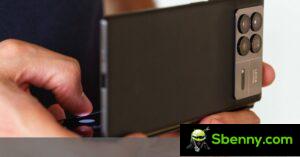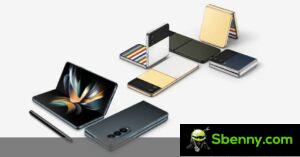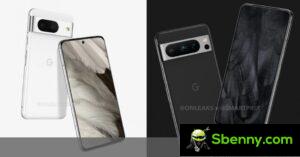introduction
As you may know, Oppo is a major sponsor of arguably the most prestigious tennis tournament globally: Wimbledon. The company kindly invited me to spend a day among the sacred meadows and try their latest flagships once again.
We have already reviewed Oppo Find X6 Pro and Find N2 Flip. I thought there was little useful information to add about the two phones individually. Instead, I decided to spend my time answering a different question that I’ve been receiving more frequently from friends and family lately. Are those cool looking foldable Flip phones better than existing bars?

While horizontal foldables cover a different price segment and target slightly different use cases, flips and flagship bars occupy a very similar segment, so there is understandably an overlap in potential customers. And even though I’m just basing it on the two Oppo phones, the conclusions hold true for the two classes of phones in general.
I took the two phones and decided to find out which one would be better suited to different tasks. I would always carry both with me and every couple of days I would alternate which would be my primary device to minimize bias.
Project
The Find X6 Pro is a great looking phone with a leather back and an interesting camera module, and I doubt anyone would care about how it looks. However, it still doesn’t come close to the appeal of the Find N2 Flip – and that’s not just my opinion either.

When you take them out in public, the foldable attracts much more envious glances. The Find X6 Pro might get the occasional compliment, but people are so used to dismissing phones that all feel the same. The Find N2 Flip, on the other hand, is an instant conversation starter and for all the right reasons too.
And there’s something so satisfying about opening your phone to answer a call and then slamming it shut after you’re done. A point to the shell here.
Battery life
The numbers in our test give the Find X6 Pro a slight edge, and if you kept the N2 Flip open all the time and used the two phones in the same way, that would probably translate into real life. There’s a catch, though: Since the N2 Flip has a fairly usable external screen, you don’t need to open it and light up the home screen every time you get a message and want to check it.
You can, or rather you should, use the external screen even when taking selfies as it offers you far superior quality to that of the main camera. And if you are a photographer or just visit interesting places like me, this will significantly contribute to battery savings.

So the two phones looked pretty much identical when it came to battery life. If one had an edge, it was small enough to go undetected in everyday use.
One difference I felt was charging times. While the N2 Flip is probably the best of the clamshells in this respect, its charges still felt slow compared to those of the Find X6 Pro. I could get up in the morning, plug in the Find : a luxury not afforded by the N2 Flip. For this reason I would give bar phones the edge, but perhaps not the full point.
Camera
Bar flagships have a clear advantage over flip phones when it comes to hardware, and the duo I tested on is no exception. The Oppo Find However, the comparison with real life was far from one-sided.
When it comes to daylight shots, smartphones have come so far that even mid-range users can take great shots today. And the Find N2 Flip is far better than a mid-range device, so there’s little wrong with its output. That’s why for good light shots I mostly ended up using whatever phone was my main one at the time.
The only exceptions were distant objects, which would exclusively require using the Find X6 Pro – the Flip’s 23mm main camera was almost useless for those.
On the other hand, selfies would be the domain of the Find N2 Flip. Although the two phones have identical 32MP selfie cameras, the external screen allows the foldable to use its main camera to take photos of yourself. That primary shooter that can run circles around regular selfie cameras, not to mention it has ultrawide backup on its side.
The video camera mode also came in handy, literally, as it seemed more convenient than regular video recording. The N2 Flip’s ability to act as a tripod when placed semi-folded on a flat surface is even more convenient. The last much-loved feature enabled by the external screen is the preview it allows when shooting other people, so they can fine-tune their pose.

However, when it got really dark, I went back to the Find X6 Pro, which turned night into day and then gave it a little color if you wanted. And because I value low-light and telephoto performance over selfies, I’m giving this one a spin to the bar phone team. Many people would be perfectly happy with the Find N2 Flip’s camera output, and selfie enthusiasts will probably even prefer it to the X6 Pro.
Productivity and general use
Once unfolded, the Find N2 Flip would match any bar phone in terms of what you can do with it. And since the overlay screen barely contributes to what you can achieve with the phone, things look pretty uniform. Once again, the foldable shape adds a twist, only this time it’s not in its owner’s favor.
You have to open your phone every time you want to do something with it, whether it’s reply to a message, check Google Maps, or browse the web, it’s a hindrance when you’re a regular user. It’s an extra step every time you want to do almost anything, and extra steps are never a good thing.
On the other hand, carrying around the dust-box-shaped Find N2 Flip is noticeably more fun than packing the Find all to his rival flip. The 25g of extra weight was easily felt even when I was wearing jeans, let alone shorts.
With the first two rounds evening the score, the category is finally decided by management, who sends it in favor of the Find X6 Pro. The Find N2 Flip is a very slippery phone, while the vegan leather of the bar flagship simply sticks on the fingers. Putting the case on the fold helped a little, but the hard plastic isn’t that grippy either. And using a foldable phone with a case adds so much bulk that it ruins the entire carrying experience.
Wrap
There’s no point in adding up the score here: Everyone’s usage patterns are different, so producing a single final score would be meaningless at best and misleading at worst. Instead, I suggest you count the chapters that interest you and then get your personalized score.

The short conclusion is this: if you love the design, choose the foldable and you won’t regret it; if the flexible body doesn’t evoke strong feelings, you’re probably better off with a boring old bar phone.
That said, it’s been 16 years since the first modern touchscreen phones were born – centuries in the world of technology, so everything about the form factor has had plenty of time to mature.
In comparison, the Galaxy Z Flip only came out 3 years ago, and it’s been barely a year since it faced real competition from the likes of Oppo and Motorola. There is still a lot to do and we will see great strides in the next generations. In fact, the Oppo N3 Flip is already official in China, and its promised global release will go a long way towards matching the camera hardware discrepancy. This article may need a revisit sooner than we think!







Start a new Thread